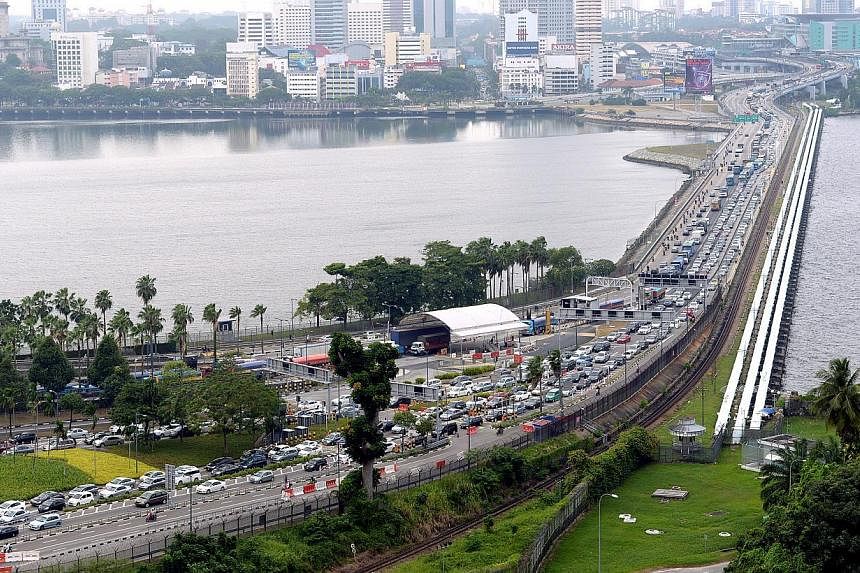Yesterday marked the 91st anniversary of the Causeway. The first bridge linking Singapore and Malaysia opened to traffic on Oct 1, 1923.
Yesterday was also the day Singapore raised toll charges sharply - one month short of 30 years since tolls were introduced on the Causeway.
Together with a similar increase initiated by Malaysia in August, a round trip to Malaysia using the Causeway now costs about $13.10 - more than five times the cost before the revisions. The cost of a similar trip using the Second Link in the west remains unchanged at $12.40.
In the first 61 years of its operation, the bridge was a free thoroughfare. It was not until 1967 that immigration control was implemented.
According to SingaporeInfopedia, an electronic encyclopedia on Singapore's history, there was a proposal for immigration control when Malaysia became independent from Britain in 1957. But this was shelved for fear that it would impede trade and affect the Malaysian economy.
Immigration control finally came into effect two years after Singapore's separation from Malaysia in August 1965, following a chequered short two years when the two were one country in the Federation of Malaysia.
And pretty much since then, the Causeway has been a constant symbol of the often uneasy ties that bind the two neighbours.
It was, on many occasions, a bridge over troubled waters: when racial riots broke out in 1964, and only people with special passes could cross; when water supply talks broke down (more than once); and even when the Malaysian side instituted on-off measures that made it a bit more cumbersome to cross (white immigration forms, fingerprint readers).
And, of course, whenever toll fees were raised.
The Causeway was also, according to Malaysia, an impediment to shipping. In 1996, then Malaysian prime minister Mahathir Mohamad proposed that the Causeway be replaced by a raised bridge that would allow ships to pass. Singapore, keen to preserve the competitiveness of its port, objected.
Interestingly, it was also in 1996 that Singapore's former prime minister Lee Kuan Yew dropped a bombshell when he said that Singapore-Malaysia reunification could happen, albeit under certain conditions.
"It will be difficult to achieve for a very long time, but I hope it will happen," Mr Lee, who turned 91 recently, said then.
In 2007, he again made a similar remark publicly. That year, Malaysian Prime Minister Najib Razak scrapped Dr Mahathir's plans for a "crooked bridge" and said the Causeway would remain.
On both occasions, Mr Lee's comments created shockwaves on both sides of the Causeway, even if it is doubtful that anyone in power actually took them seriously. Of course, talk about the two countries becoming one again is just fodder for good coffee shop banter now. Just as the sharp toll hikes are a talking point on both sides of the Causeway, even if the much-hyped economic impact is dubious.
For instance, companies that transport goods by truck are unlikely to stop doing so. The toll charges represent an insignificant portion of the total cost, which includes fuel, labour and far heftier charges for using the North-South Highway.
And when divided by the sheer volume of goods transported per truck, the increase becomes negligible. For instance, a lorry can carry up to 20 tonnes of vegetables or around 3,000 chickens.
Those who might feel the pinch are unlikely to seek alternatives by sea or air. One is too slow, and the other way too costly.
Malaysians who come to Singapore for work mostly travel by motorcycle and are not affected by the toll hikes. Firms that have operations in Johor Baru are in a better position to absorb the hikes - after all, they benefit from far lower costs than rivals in Singapore.
As for leisure travellers who drive up to Malacca or Kuantan two or three times a year, tolls on both crossings are insignificant in relation to total expenses.
Malaysians who come to Singapore to shop and dine are wealthy individuals who do not baulk at the unfavourable foreign exchange in the first place.
The ones affected by the toll hikes are people who make cross-border commutes for cheap food and fuel in JB.
Herein lies the conspiracy theory: that both governments want to dissuade these activities. Because even as Singaporeans contribute to thriving trade for shopkeepers and realtors in JB, they also fuel rises in the cost of living that affect Johoreans at large. Not to mention the congestion.
The theory is that Singapore prefers such spending to be done at home, for obvious reasons.
As independent countries go, Singapore is a youngster at 49, and Malaysia only eight years older. At the end of the day, it is premature to talk about any remarriage. It may, however, be the right time to go on dates.
And certainly, both sides have been making overtures.
The high-speed rail link from Kuala Lumpur to Singapore, the MRT extension to Johor Baru, the proposed Friendship Bridge - all are physical links that, like the Causeway, will bind the two neighbours that are so near, yet so far.

